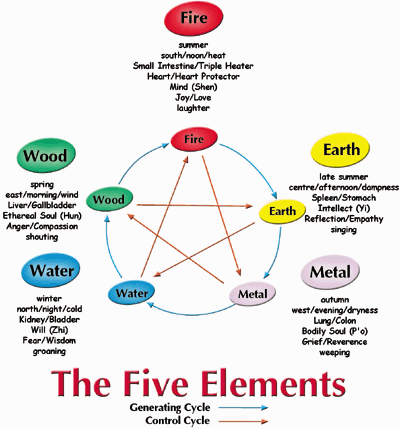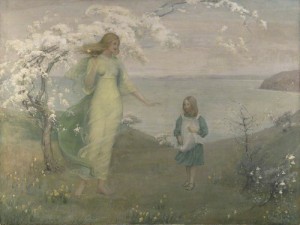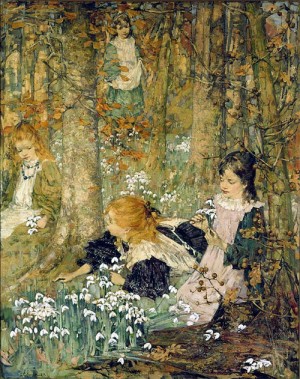Spring, 2015
Spring Mountain Spring Moon
The sun hits the celestial equator today at 4:45 pm. It also rises due East and sets due West. This is the day the serpent crawls up Chichen Itza. Though meteorological spring, the three months between the coldest and warmest months, began on March 1st, today is the old holiday, one celebrated in cultures across many lands.
Here, for example, is an interesting paragraph about spring from the perspective of wu xing: “In Chinese thought, spring is associated with the color green, the sound of shouting, thewood element, the climate of wind, things sprouting, your eyes, your liver, your anger, patience and altruism– and a green dragon. Not surprisingly, spring is also associated with the direction east, the sunrise direction as Earth spins us toward the beginning of each new day.” earth and sky
Spring sees the early evidence of winter’s end, celebrated at Imbolc, when the lambs are in the belly, brought forward. The lambs are born. The grass is plentiful so the ewes can give milk and nourish their babies. The gradual loosening of winter’s cold and snow and ice continues, accelerates until the days have warmth as their usual state.
The warmth and the sun climbing toward the north signal plants and animals both. Hibernation ends so the visible population of critters increases rapidly, coming out for the food the new season promises. Spring ephemerals burst out of the snow: snowdrops, crocus, aconites. Later, the daffodils will come, too. The strategy of the spring ephemerals is an interesting one. They emerge, bloom and die back before whatever is in the surrounding vicinity can leaf out, thus capturing all the available sunlight before shade covers their spot.
If Michaelmas is the springtime of the soul, then the vernal equinox is the springtime of the body, of the material and animate world. No surprise then that it serves as the proximate marker for the Christian easter, focused as it is on the resurrection, the new life of the body. Both Christmas and the Easter, the two key Christian holidays, one marking the incarnation and the other the death and regained life of Jesus, focus on the body and its possibilities. In the first instance the body is seen as a vessel for the divine and in the second the body is seen as no longer bound by the strict laws of the animal world. Death is no longer the end.
The Great Wheel suggests a similar, but profoundly different way of viewing these two most profound mysteries: birth and death. The Great Wheel focuses on the rhythms of the natural world and on their sequence, their repetitiveness. Taken most literally it adds nothing to these rhythms, nor does it subtract from them. Birth and death occur as the great wheel turns, as the earth revolves around the sun, source of the vital energy that maintains life between these antipodes.
This intricate interdependence between animals and plants in their life cycles, the sun and the earth’s orbit around it, is common, literally mundane. Profane, too, I suppose. Yet the miraculous is here, too and we need no sacred text to see it. Out of the stuff born in the birth of the stars themselves, stuff borne later on the solar wind and in the cataclysmic explosions at the deaths of these same stars, came the material that created our sun and our home, this planet, this earth.
 Then, consider what happens next. That same stuff, now reordered and shaped into this planet, somehow reconfigured itself so that it could move, so that develop intention and instinct, so that it could replicate itself rather than having to wait for the violent processes more usual for the distribution of matter. And that that stuff, the same from the heart of the stars, so reconfigured, grew in complexity and capability until human babies began to born. Babies that could, probably for the first time here on earth, perhaps for the first time in the whole of the universe, see that which gave them the potential for life, the universe in its particularity here on earth and its dizzying universality in the cosmos.
Then, consider what happens next. That same stuff, now reordered and shaped into this planet, somehow reconfigured itself so that it could move, so that develop intention and instinct, so that it could replicate itself rather than having to wait for the violent processes more usual for the distribution of matter. And that that stuff, the same from the heart of the stars, so reconfigured, grew in complexity and capability until human babies began to born. Babies that could, probably for the first time here on earth, perhaps for the first time in the whole of the universe, see that which gave them the potential for life, the universe in its particularity here on earth and its dizzying universality in the cosmos.
The birth of the universe’s own eyes and ears and poets and composers and painters and dancers came and as miracles. And still do. In the same way the death of these same poets and artists does not end the births. No, the births keep coming and the deaths do not end them. In my mind this is the true resurrection, the actual reincarnation, the exact moment of rebirth. Death does not end us. We continue. And Spring is just the season to bless and hold this true miracle close to our hearts.



euxbwt